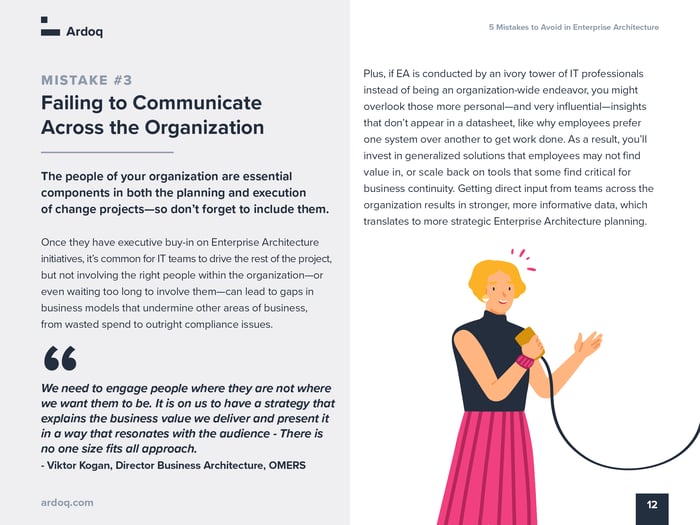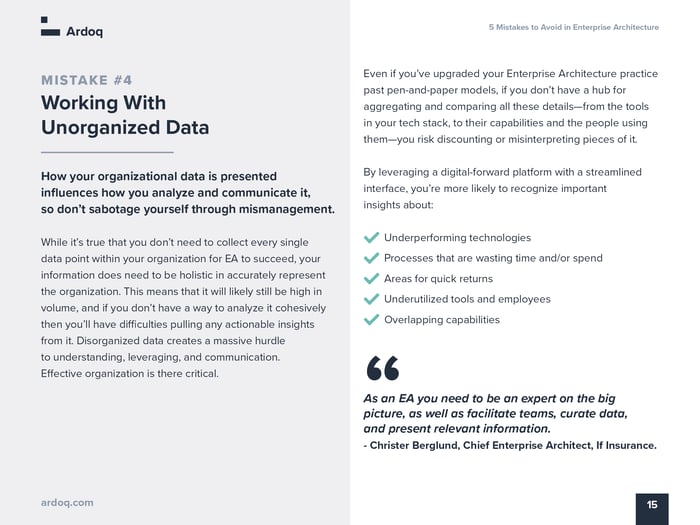5 Mistakes to Avoid in Enterprise Architecture
Don’t jeopardize your efforts by making these common mistakes.

Ardoq Is Trusted by Digitally Forward Companies Worldwide
Enterprise architects share their biggest sources of trouble when executing change projects.
Under pressure to digitally transform, many organizations are falling into the same traps when it comes to executing EA, with consequences ranging from falling short on business objectives, to leaving the business vulnerable to breakdowns and security breaches.
To avoid these mistakes in your own efforts, it helps to first understand what they are and why they happen.
Whether you’re looking for ways to optimize existing assets or undergoing brand-new digital transformation initiatives, this survey report will tell you how to avoid the most common mistakes, as told by more than 100 surveyed Ardoq customers.
1. Not Aligning Enterprise Architecture Initiatives With Business Goals
The pressure to transform can lead you to chase change projects without first defining how those projects offer clear and measurable value to their business. As a result, you’ll overcomplicate processes unnecessarily and invest in tools that don’t address employees’ pressing needs.
As you plan your Enterprise Architecture initiatives, consider:
What changes can we make to take our business from where it is today, to where we want it to be tomorrow?
2. Working With Low-Quality Data
Eager to get projects underway, you might perform a shallow and static assessment of key project variables. But within any organization, there’s a myriad of interconnected and constantly evolving systems, processes, products, and people that all need to be taken into consideration for Enterprise Architecture to work.
Without a contextualized, up-to-date understanding of the business ecosystem you’re working within, you can’t accurately predict the organizational impact of change.
3. Failing to Communicate Across the Organization
Not involving the right people within the organization—or even waiting too long to involve them—can lead to gaps in business models that undermine other areas of business, from wasted spend to outright compliance issues.
The people of your organization are an essential component in both the planning and execution of change projects—so don’t forget to include them.
4. Working With Unorganized Data
You’ve collected robust organizational data—now what? If you don’t equip yourself with the means to analyze it cohesively, you’ll struggle to pull any actionable insights from it. This also shortchanges your ability to communicate the value of your efforts.
How your organizational data is presented influences how you analyze and communicate it, so don’t sabotage yourself through mismanagement.
5. Relying On Enterprise Architecture Values That Are Too Rigid
Change isn’t always linear, so if your Enterprise Architecture program can’t be adjusted as projects progress, then you’ll either move ahead with inaccurate solutions or waste significant time and spend starting over with the process.
To be agile during changing circumstances, focus on driving change that’s valuable to colleagues instead of adhering to strict and potentially dated expectations of what success looks like.
Enterprise Architecture boasts big promises when it comes to achieving digital transformation, but pulling it off successfully requires proper planning and tooling.
Be strategic in how you engage your organization throughout the entire Enterprise Architecture process. Not only will you be able to overcome common change management roadblocks, but you’ll also be able to achieve synergies across teams and operations like never before.
Download the Survey Report to Learn More
Know what to avoid when it comes to implementing Enterprise Architecture within your organization.
This survey report is based on responses from Ardoq customers, and might not be representative of all Enterprise Architects and related stakeholders.



